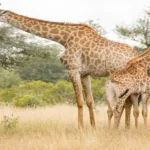In the urgent call for action in today’s world, the urgency of forest and wildlife conservation stands as a beacon.
This concept revolves around safeguarding our natural environments, acknowledging the pressing need to protect and preserve the delicate balance of ecosystems.
Forests and wildlife are not just components of nature; they are lifelines, playing a critical role in sustaining the delicate web of life on Earth.
These ecosystems serve as the lungs of our planet, absorbing carbon dioxide and providing the oxygen essential for life. Moreover, they host an incredible diversity of species, contributing to biodiversity and ensuring the resilience of our global environment.

Urgency of Forest and Wildlife Conservation
In the present era, the state of forests and wildlife globally raises a red flag, demanding our immediate attention. Across the world, our natural habitats are facing unprecedented challenges, threatening their very existence.
Deforestation, the clearing of large expanses of forests for various purposes, poses a grave threat to biodiversity and disrupts the intricate balance of ecosystems.
Simultaneously, habitat loss due to human activities encroaches upon the living spaces of countless species, pushing them towards endangerment or extinction.
Climate change adds another layer of complexity, impacting temperature patterns, precipitation, and overall environmental conditions.
These environmental threats cast a looming shadow on the future of our planet. The urgency to address these issues cannot be overstated.
Immediate action is crucial to curb deforestation, protect habitats, and mitigate the impacts of climate change.
The delicate interdependence between species and their environments requires a swift and collective effort to ensure the survival of diverse ecosystems.
As we grapple with the urgency of conservation, we are confronted with the responsibility to act decisively and safeguard the natural wonders that sustain life on Earth.
Why Should We Conserve Forest and Wildlife?
Preserving forests and wildlife is not just a choice; it’s a necessity for the well-being of our planet and all its inhabitants. The reasons for conservation are as diverse as the ecosystems we seek to protect.
Biodiversity, the rich variety of life forms on Earth, holds a crucial ecological importance. Each species, from the tiniest insects to the towering trees, plays a unique role in maintaining the delicate balance of nature.
The interconnectedness of these species forms a web of life, where the well-being of one directly impacts the others.
Conservation isn’t merely about saving habitats; it’s a key player in climate regulation. Forests act as Earth’s lungs, absorbing carbon dioxide and releasing oxygen, stabilizing our climate.
Moreover, these natural havens influence water resources, acting as filters for freshwater and maintaining water cycles. Beyond environmental benefits, conservation directly impacts human well-being.
Forests provide resources for medicine, food, and livelihoods, making their preservation integral for sustainable living.
As we delve into the why of conservation, we unravel a tapestry of interconnected reasons, each thread essential for the health and balance of our planet.
Also Read: How Industrial Activities Pollute The Environment
Biodiversity and Ecosystem Services
Biodiversity, a term often heard but not always fully understood, refers to the incredible variety of life on our planet. It’s like a grand buffet where every species, big or small, has a unique role to play.
Now, imagine this buffet as a complex web, where each species is a vital thread. This interconnectedness is what we call an ecosystem, a dynamic community of living organisms and their surroundings.
Forests and wildlife contribute significantly to this biodiversity, forming vibrant ecosystems that bring stability and balance to our world.
Beyond their breathtaking beauty, these diverse ecosystems offer us valuable services, much like the perks of a well-functioning city.
Imagine a forest as a bustling metropolis: the trees act as skyscrapers, providing shelter and homes for countless creatures.
The soil serves as a foundation, filtering water and supporting plant life. And just like a city has waste disposal systems, these natural environments help recycle nutrients and maintain a healthy cycle of life.
These ecosystem services contribute to our resilience and sustainability. They provide us with clean air to breathe, fresh water to drink, and fertile soil to grow our food.
When we protect biodiversity and maintain healthy ecosystems, we’re essentially ensuring the continued availability of these essential services.
So, it’s not just about saving species; it’s about safeguarding the intricate services that nature selflessly provides, ensuring a harmonious balance for generations to come.
Conservation Success Stories
Let’s dive into some uplifting tales of triumph in the world of conservation, where dedicated efforts have made a real difference.
Take the story of the bald eagle, the majestic bird that faced the brink of extinction due to habitat loss and pesticide use.
Thanks to conservation initiatives and the ban on harmful pesticides, their population has soared, symbolizing the success of protective measures.
Down in the ocean, the humpback whale tells a similar story. Once hunted to near extinction for their blubber, these gentle giants are now on the rebound.
International agreements and conservation measures have granted them the protection needed to thrive again, showcasing the positive impact of global cooperation.
In India, the Bengal tiger faced a serious decline due to habitat loss and poaching. Conservationists implemented protective measures, including reserves, anti-poaching initiatives, and community involvement.
Through strict enforcement and penalties, the tiger population has rebounded, showcasing a successful conservation story.
This achievement not only reflects the recovery of a majestic species but also underscores the effectiveness of dedicated efforts in preserving India’s biodiversity.
These success stories not only revive the populations of endangered species but also bring broader benefits. Conserved ecosystems often see improvements in overall biodiversity, creating healthier environments for both wildlife and people.
As we celebrate these victories, they stand as beacons of hope, demonstrating that with dedication and collective action, we can indeed turn the tide for the better.
Challenges and Solutions
Conservation faces its fair share of challenges, and understanding them is key to finding lasting solutions.
Poaching, the illegal hunting of wildlife for various purposes, poses a significant threat to many species.
Similarly, illegal logging contributes to deforestation, disrupting habitats and affecting biodiversity.
Another challenge lies in the lack of awareness among communities about the importance of conservation and sustainable practices.
To tackle these challenges, collaborative efforts are essential. Implementing stricter laws and penalties for poaching and illegal logging can deter such activities.
Additionally, raising awareness through education programs helps communities appreciate the value of preserving their natural surroundings.
Engaging local communities in conservation initiatives, providing alternative livelihoods, and promoting sustainable practices are crucial steps.
Individuals can contribute by supporting conservation organizations, participating in tree-planting initiatives, and spreading awareness about the importance of protecting our environment.
By addressing these challenges collectively, we can pave the way for a more sustainable and harmonious coexistence with nature.
Conclusion
Forest and wildlife conservation is not just an option; it’s an imperative for the survival of our planet. We’ve discussed the pressing need to address challenges like deforestation, habitat loss, and climate change.
Each individual plays a vital role in this mission. By acknowledging and addressing challenges such as poaching, illegal logging, and lack of awareness, we pave the way for a sustainable future.
The success stories showcased the positive impact of conservation efforts, proving that concerted action can make a real difference.
It’s a collective responsibility to protect our ecosystems. Planting a tree, supporting conservation initiatives, and spreading awareness are tangible ways to contribute.
The urgency of conservation cannot be overstated, and as stewards of Earth, our choices today shape the legacy we leave for generations to come.
Together, let’s embrace this responsibility and act decisively for the well-being of our precious planet.






